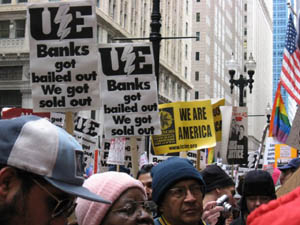United Electrical Workers Celebrate 75 Turbulent Years

At the first Labor Notes Conference, in 1981, legendary United Electrical Workers organizer Don Tormey called his union “a good deed in a naughty world.”
He was quoting Shakespeare, whose Merchant of Venice says, “How far that little candle throws his beams! So shines a good deed in a naughty world.”
The UE’s candle-power shone brightest, in my labor lifetime, in December 2008, when its members at Republic Windows and Doors in Chicago sat down inside their soon-to-be-shuttered factory, capturing the imagination of union members everywhere.
It was labor’s opening shot in the war on workers touched off by Wall Street that fall. The workers, mostly Latino immigrants, won $1.75 million from Bank of America and JPMorgan Chase in benefits owed to them. But, sadly, neither the tactic nor the militancy was taken up by other unions.
It was not the first time the UE—which celebrates its 75th anniversary this year—found itself out in front with few institutional followers. It claims to be the first union to oppose the Vietnam War, for example, in 1964. Now one of the smallest national unions, not a member of any federation, it has jealously guarded its independence and its combative politics.
The union’s convention this week, in Pittsburgh, showed the UE spirit alive and kicking despite the hammering it’s taken along with the rest of the labor movement.
Membership in its small-factory base fell hard as manufacturing declined, causing a turn to organizing in the public sector. Its members work in scattered small shops. At its largest employer, General Electric, only 15,000 workers are still union members, after years of plant closures, and only about 3,500 of those are in UE. This year, in bargaining with UE and 10 other unions, GE succeeded in ending defined-benefit pensions for new hires.
Despite reverses, UE has taken on daunting tasks. Through Warehouse Workers for Justice, it is organizing among the 150,000 warehouse workers in the Chicago area, where the Joliet complex is the third-largest container port in the world and where employment is fragmented among temp agencies serving the likes of Walmart and Home Depot.
Warehouse workers at the convention told of being paid by the piece or the trailer-full rather than an hourly rate, of getting a $350 check for a week’s work, and of working among swastikas and other racist graffiti on warehouse walls. The union has organized marches on the boss, gotten the graffiti scrubbed, and filed class-action lawsuits to combat employers’ theft of workers’ wages.
No less ambitious in the public sector, UE has three nonmajority locals in Virginia, West Virginia, and North Carolina, where the union struggles to represent public workers despite no legal rights to collective bargaining. In West Virginia 1,200 members statewide find union membership valuable enough to pay $17 a month to belong.
UE’s international solidarity work would put to shame a union ten times its size. It has long worked with the Authentic Labor Front (FAT) in Mexico, a federation independent of the government-controlled unions, mobilizing solidarity, sending delegations of rank and filers south, and hosting FAT members in the U.S.

SUPPORT LABOR NOTES
BECOME A MONTHLY DONOR
Give $10 a month or more and get our "Fight the Boss, Build the Union" T-shirt.
At the convention, FAT leader Benedicto Martinez told the crowd that a recent victory for the embattled electrical utility workers in Mexico City was a “triumph for international solidarity.” He pointed to an auto parts shop newly organized by the FAT that is the sister plant of an Ohio UE local.
UE members practice solidarity at home, too. UE members from 17 states traveled to Wisconsin to join in the protests there last winter.
Smaller but Better
How did UE end up “smaller but better”? It was founded in 1936 from a merger of independent locals, grew with the CIO, and took part in the 1946 strike wave that put hundreds of thousands of workers in the streets.
But when McCarthyism took hold, UE was targeted as a “red” union, expelled from the CIO, and raided 500 times by other unions in 1947-1949 alone. CIO leaders set up a new union, the IUE, to replace UE as the new union for GE and other electrical workers.
Yet UE refused to give up and go away. Today the members’ enthusiasm for their union is obvious, giving the convention a feel very different from that of many unions’ stage-managed affairs in Las Vegas. UE’s gathering feels informal, boisterous, family-like.
While many unions have trouble keeping their convention delegates awake, UE delegates listen closely to pretty much everything. Its “Young Activists” section—the most enthusiastic of all—is a conscious attempt to keep the spirit going for another 75 years.
In the early 2000s Service Employees (SEIU) strategist Stephen Lerner, whose advocacy of mega-unions stirred up controversy, called UE a “corner store union.” Such unions, Lerner said, “don't control a market, they can't drive prices….They have no real power or ability to change, influence, and improve conditions in society.”
It’s true that UE doesn’t have industries organized densely enough to set pattern agreements (and SEIU is struggling there, too).
But how many union members—and others—were inspired by the Republic workers’ sit-in—an action virtually no other union would permit, much less help to organize? There’s a reason UE is disproportionately represented in the pages of Labor Notes and our Troublemaker’s Handbook: the creativity and boldness of its actions, particularly on the shop floor.
The power of a good example can break things open, too.




